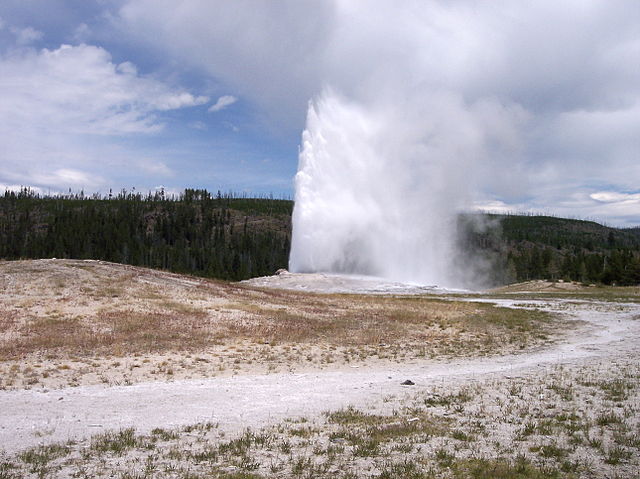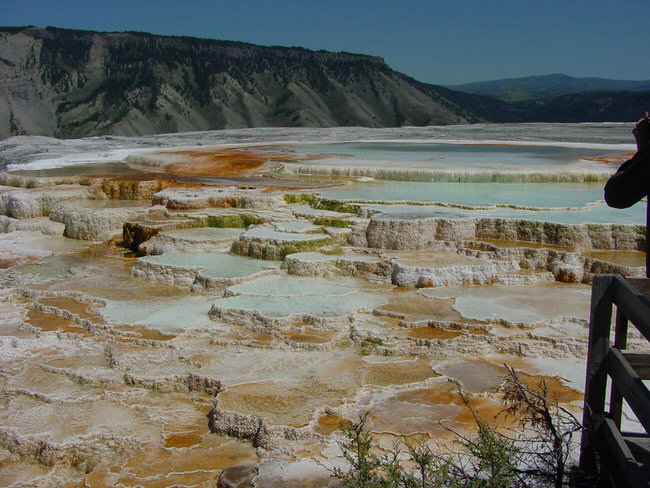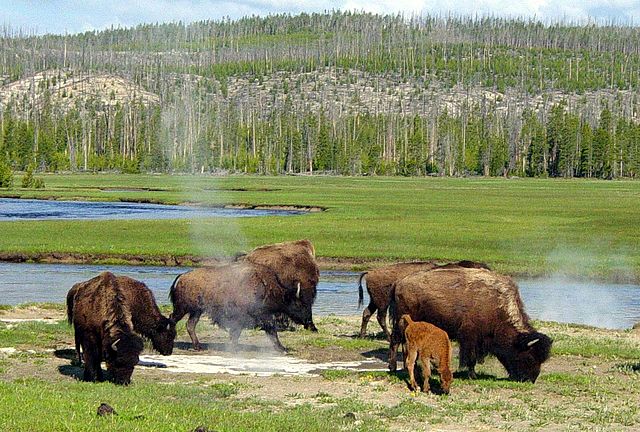
Wyoming
Here you’ll discover some great Wyoming Hotel Resorts. Welcome to the Cowboy State. Whether you want to follow in the footsteps of our Western pioneers, experience Native American culture first-hand, explore the state’s many natural wonders, brave the rapids of our world-famous rivers, carve powder-dusted slopes of our exceptional ski areas, stay for a spell on a working cattle ranch, join in the Western fun in any of our diverse cities, challenge the state’s sheer rock faces, head out on a mountain biking adventure, pitch your tent for some time around the campfire, visit the country’s oldest National Park or drive through some of the country’s most scenic countryside, there’s plenty to see and do in Wyoming.
Recreational opportunities abound in Wyoming from digging up fossils to kayaking on Lake Yellowstone. All roads do lead to something in Wyoming. Stop and experience the endless sights and activities on the way to or back from Yellowstone and Grand Teton National Parks.
Avoid time consuming mistakes, costly mistakes. For the best results please use our vacation planner to be contacted by our renowned Virtuoso Travel advisors that specializes in Wyoming. We do it all for you, air, car, hotels, and everything else you desire.
From the thrill seeker to the nature lover, Wyoming has something to please everyone. Spend your summer days watching wildlife in a grassy meadow or catch one of Wyoming’s breathtaking panoramic views from a mountaintop. If you’re a little more adventurous try river rafting, Skiing, horseback riding, fishing, hiking, canoeing, or camping. We’ve got it all.
Wyoming is often called the first state in outdoor America. From the thrill seeker to the nature lover, Wyoming has something to please everyone. We’ve got two fantastic National Parks and a dozen State Parks.
Try your hand at running the Snake River on a commercial float trip, herding cattle in the Big Horn Mountains, biking in the Snowy Range, climbing the Tetons or stargazing in the Red Desert. Name an outdoor activity and it’s probably done here!
You can hike, backpack, fly-fish. Try wildlife photography or birdwatching. Head out on your own or with equipment and guides ready to serve you. Go rock climbing, kayaking, snowboarding, parasailing, hang gliding, windsurfing, jet skiing or spelunking – just a few of the outdoor activities to enjoy in Wyoming.
Every area has something unique to call its own in Wyoming. You can see Devil’s Tower from the tee at the town of Hulett’s fine, new golf course. The general store in the town of Aladdin is over 100 years old. You’ll want to get a picture of the family seated out front of the store on the “Liar’s Bench.”
Driving through Wyoming is part of the enjoyment as the state’s scenic byways will provide a scenic backdrop to your trip. Visitors can drive through picturesque mountain scenes along rivers and through canyons. Check out Wyoming’s scenic byways.
Downhill Skiing and Snowboarding:Â Wyoming’s Intimate Resorts – Wyoming has several ski resorts that still have great Skiing and snowboarding, without busloads of people.
Big Horn Mountain Resorts – The Big Horn Mountain Resort promises crowd-free slopes and lots of powder. Swoosh down over 20 runs in the Big Horn Mountains. Slope ratings are 30% beginner, 40% intermediate, and 30% advanced. Other features make Big Horn Mountain Resort a favorite among snowboarders, including half-pipes, terrain park, and snowboard cliffs.
White Pine Ski Area – Just ten miles from Pinedale, skiers will be awed at the beautiful and rugged Wind River Mountains. There are currently 370 skiable acres, but White Pine is still expanding. Twenty percent of the acres are for beginners and 60% are for intermediate skiers. All the runs for beginners and intermediates are groomed. The last 20 percent. You¹d better be good.
Sleeping Giant Ski Area – Just east of Yellowstone National Park, many take advantage of this Ski Area in the Wapiti Valley on their way to and from the park. The 17 runs on 80 acres down a 500 foot vertical drop is what keeps skiers and snowboarders coming back. This is a great area for those who enjoy both downhill and cross-country skiing. The Wapiti Valley has 35 kilometers of skinny ski trails that are accessible through the downhill ski area.
Pine Creek Ski Area – Die-hards love the 1,200-foot vertical drop at the Pine Creek Ski Area, just East of Cokeville. Thirteen different runs will challenge skiers and boarders of all skill levels. This small friendly ski area is open Friday through Sundays from 10 a.m. to 4 p.m.
The Snowies – If you’ve ever thought about hitting the slopes in June, then you know about the Snowies. At 9,500 feet it isn’t unusual for winter activities to carry over into the early part of June in the Snowy Range. The Snowy Range Ski Area is a great place for the whole family with trails classified as 25% beginner, 50% intermediate, and 25% advanced. This southeastern Wyoming ski area has 25 runs for skiers and snowboarders serviced by 4 chair lifts.
Wyoming is home to the first national park, Yellowstone, and the first national monument, Devils Tower. The wildlife and the geothermal features like Old Faithful are some of the main attractions at Yellowstone National Park. Looming over 1,280 feet in elevation, Devils Towers has always stood out to those traveling through the area. Grand Teton National Park attracts attention for its high spires erupting from the Jackson Hole Valley. Fossil Butte National Monument takes visitors back millions of years to when the area was an ocean.
Through hikes, camping, photography, presentations and wildlife watching, visitors can discover hands on why these places have captured our imagination for centuries with their wild beauty.
Yellowstone National Park: We enter a new century with Old Faithful as wondrous as ever in the world’s first national park, Yellowstone – located in the northwest corner of Wyoming. President Ulysses S. Grant signed into law the bill to create Yellowstone National Park in 1872. The nation’s first national park still remains primarily a wilderness with 99 percent of the park’s 3,400 square miles (2.2 million acres) remaining undeveloped.
While Old Faithful, the most widely recognized geyser, serves as the park’s signature steam, there are more than 10,000 other geothermal features in Yellowstone including geysers, hot springs, mudpots and fumaroles. In recent years some geysers which had been dormant began spouting off again. Cold water has a major role to play in the pleasuring grounds of the park as well. The Yellowstone River drops over 400 feet in two waterfalls cutting a grand canyon deep into the golden-hued rock that gives the park its name.
Family adventures in Yellowstone are boundless. Touring motor coach excursions run several routes from late May through September. One and two-hour horseback trail rides are available from Mammoth Hot Springs, Roosevelt Lodge and Canyon Village. Stagecoach travel is an option out of the Roosevelt Lodge area where the popular Old West Cookout completes the day from mid-June through early September. If you are in need of water, take a scenic cruise on Lake Yellowstone. Guided fishing trips on a cabin cruiser can yield great catches. Row boat and outboard rentals are provided mid-June to mid-September.
Picture-perfect photo safaris originate from Lake Hotel and Lamar Valley wildlife excursions add to the park’s endless learning experiences. Might you see a wolf? More and more people are – given the proper insight. You will see bison, elk, and many more of Yellowstone’s wild creatures.
Grand Teton National Park: Grand Teton National Park is an ethereal mountain landscape where jagged peaks tower more than a mile above the Jackson Hole valley. The park was originally established in 1929, but grew with a large addition of land in 1950. The entire area of Grand Teton National Park is now almost 500 square miles, 98 percent of which is federally owned.
The park is located in northwestern Wyoming just south of Yellowstone National Park and just north of the town of Jackson. Visitors can reach the park through U.S. 191.
The park’s mountain range is very popular among climbers, hikers and photographers. The Tetons are a prime example of fault-block mountain formation. When the earth’s crust cracked along a fault millions of years ago, the Tetons rose into the sky. The exposed crystalline rocks give these mountains their dramatic appearance in any season. The Grand Teton rises to 13,770 feet above sea level and 12 other peaks reach above 12,000 feet elevation. The floor of the valley tells the story of glacial outwash where streams carried out glacial sand and boulders.
More than 60 species of mammals, over 100 species of bird and a half a dozen game fish call the Jackson Hole area home. The American elk is the most common member of the deer family in the Park. During the summer, the elk range high in the mountains in search of food. When winter comes, they again descend to the floor of Jackson Hole, many to the National Elk Refuge just north of the town of Jackson.
Grand Teton National Park offers hiking, camping, climbing, boating, kayaking and numerous photography opportunities. A road winds through the park, but the best way to experience the park is to take one of its shorter trails.






